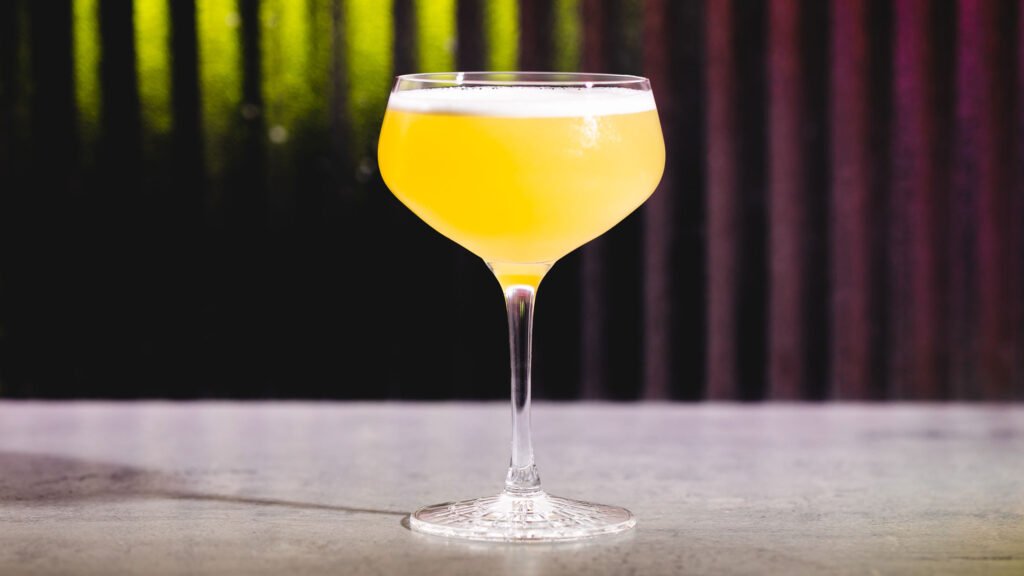[ad_1]
Everyone knows the Mai Tai, a drink consisting of aged rum, lime, Curaçao and orgeat that was invented by Victor “Trader Vic” Bergeron in California in the 1940s. It’s been popular ever since, living on in tiki culture, tropical resort towns, Polynesian and Chinese restaurants and regular old bars. But far fewer bargoers are aware that there’s another Mai Tai floating around in the recesses of tiki history: Don’s Mai Tai. At Satan’s Whiskers in London, however, Daniel Waddy and his team are turning their patrons on to its charms.
Jeff “Beachbum” Berry’s Total Tiki app asserts that the Donn Beach Mai Tai—also known as the Mai Tai Swizzle—likely came about in the 1950s. Berry writes that Beach was likely pushed into creating his own Mai Tai to rival the one at Trader Vic’s—which is only fair, given that Don the Beachcomber was Vic’s chief inspiration for his bar. But Phoebe Beach, Donn’s widow, claimed in her 2001 book, Hawai‘i Tropical Rum Drinks and Cuisine by Don the Beachcomber (which she wrote with her husband, Arnold Bitner), that Donn Beach had invented a drink called the Mai Tai in 1933.
Waddy of Satan’s Whiskers points out that, yes, Beach could have known the Tahitian word “maita‘i” from his travels in the South Pacific and that Bergeron could have picked up the name from him. The thing is, even if this were the case, Beach’s version bears no resemblance to Vic’s at all—and as a result, doesn’t look much like a Mai Tai to our modern eyes. “There’s a common name,” says Waddy, “but it’s definitely not the same drink.” The recipe published in Beach and Bitner’s book calls for both Jamaican and Cuban rums, falernum, Cointreau, lime, grapefruit, Angostura bitters and Pernod. The mixture is shaken with cracked ice, served in a rocks glass and garnished with mint and pineapple.
Waddy characterizes Don’s Mai Tai as a “small-format Zombie,” with classic “Don-isms” like grapefruit, falernum and absinthe, which can be found in a great many of his “rhum rhapsodies.” At Satan’s Whiskers, the recipe stays relatively close to the original, but with one big change to the base: cutting out the Cuban rum entirely, which brings down the overall ABV of the drink—it’s a mini Zombie that you can have more than one of. “Sometimes you don’t want to drink a whole Zombie,” he explains, but you want to experience those flavors.
For the remaining rum, Waddy isn’t too fussy about which expression is included, noting only that it shouldn’t be too boozy or too funky. “You want some sort of aged Jamaican rum in the kind of 40-ish ABV mark,” he says. “You want some of those Jamaican ester-y flavors.” At Satan’s Whiskers, bartenders often reach for Appleton 8-year, but Waddy says the brand’s Signature blend would also work, as would a more classic “dark rum” like Myers’s.
Though the original Don’s Mai Tai recipe called for Cointreau, the version at Satan’s Whiskers opts for Curaçao instead. This choice reads as a nod to the far more famous Trader Vic’s Mai Tai and its showcase of Curaçao, while also shifting the overall flavor of the drink. “When you’re using it in conjunction with grapefruit juice,” says Waddy, “it makes for a little bit more of a rounded profile rather than the bright and zingy profile [of triple sec].” At Satan’s Whiskers, bar staff use Edmond Briottet, but Waddy says Pierre Ferrand would also work well in this drink.
For the falernum, Waddy reaches for the well-established industry favorite John D Taylor’s Velvet Falernum. Though he affirms that there are a lot of great falernums available with a range of complex and “more pervasive” flavors, the Taylor’s product “plays well with others”—an important quality in a drink with eight ingredients. Like the original does, he also uses Pernod’s absinthe.
The Don’s Mai Tai at Satan’s Whiskers is shaken and dumped into a double rocks glass, then topped with crushed ice and garnished with mint (like Vic’s Mai Tai), a lime wedge and a brandied cherry. The crushed ice mellows out the heavier elements of the drink. “It’s rich, but still something that you could drink on a hot day,” says Waddy. Compared to Trader Vic’s more famous variation, he appreciates that “it’s a sort of subtler, more nuanced kind of creation.”
[ad_2]


